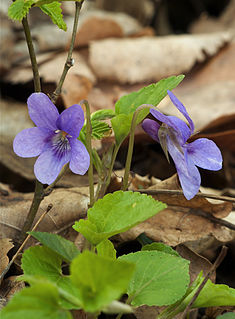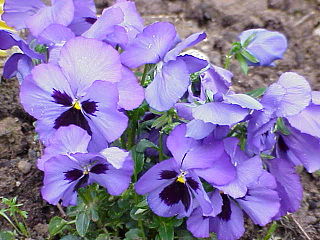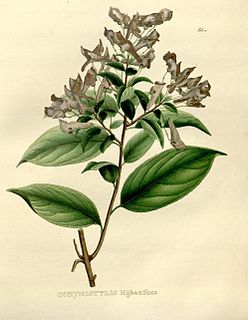
Viola is a genus of flowering plants in the violet family Violaceae. It is the largest genus in the family, containing between 525 and 600 species. Most species are found in the temperate Northern Hemisphere; however, some are also found in widely divergent areas such as Hawaii, Australasia, and the Andes.

Violaceae is a family of flowering plants established in 1802, consisting of about 1000 species in about 25 genera. It takes its name from the genus Viola, the violets and pansies.

Violales is a botanical name of an order of flowering plants and takes its name from the included family Violaceae; it was proposed by Lindley (1853). The name has been used in several systems, although some systems used the name Parietales for similar groupings. In the 1981 version of the influential Cronquist system, order Violales was placed in subclass Dilleniidae with a circumscription consisting of the families listed below. Some classifications such as that of Dahlgren placed the Violales in the superorder Violiflorae.
Grias cauliflora, the anchovy pear, is a fruit native to Jamaica, Central America, and Colombia. It is often found near rivers or marshes in large colonies. It grows on the evergreen tree Grias cauliflora of the Lecythidaceae family.

Carica is a genus of flowering plants in the family Caricaceae including C. papaya, the papaya, a widely cultivated fruit tree native to the American tropics.

Cauliflory is a botanical term referring to plants that flower and fruit from their main stems or woody trunks, rather than from new growth and shoots. This can allow trees to be pollinated or have their seeds dispersed by animals that climb on trunks and sturdy limbs to feed on the nectar and fruits. Plants may instead have fruit which drop from the canopy and ripen only after they reach the ground, an alternative "strategy" to cauliflory.

Jabuticaba is the edible fruit of the jabuticabeira or Brazilian grapetree. The purplish-black, white-pulped fruit grows directly on the trunk of the tree. It is eaten raw or used to make jellies, jams, juice or wine. The tree, of the family Myrtaceae, is native to the states of Rio de Janeiro, Minas Gerais, Goiás and São Paulo in Brazil. Related species in the genus Myrciaria, often referred to by the same common names, are native to Brazil, Argentina, Paraguay, Peru and Bolivia.

Cynometra cauliflora is a small, cauliflorous tree with a thick, heavily branched stem, and rather small flowers, about 1.2 cm (0.5 in) across, that appear on the stem in clusters. It is known in Indonesian as namu-namu, after the flattened, crescent shaped pods, which look similar to the Indonesian pastry, namu-namu. In the city of Ternate, it is called namo-namo, and ñam-ñam in the Maldives. It is a species of the genus Cynometra, native to Malaysia, and found mainly in northern peninsular Malaysia.

Montrouziera cauliflora, the giant Houp tree, is a species of flowering plant in the family Clusiaceae. It is found only in New Caledonia, and is one of the largest trees in the rainforests there. It is found in moist evergreen dense forest of low and medium altitude on all types of soil. The tree has a straight trunk, slightly conical, without buttresses but with a slightly wider base, up to 30 m high and 3 m in diameter, with branches protruding horizontally. Houp trees make fruit but it is not edible by humans. Damage causes the bark to exude a yellow resin, thick and sticky, with no peculiar smell. The bark is dark gray or reddish for individuals in very dense forest, with deep vertical cracks. Houp trees are sacred to New Caledonia's indigenous Kanak people, who traditionally used its wood extensively as a building material. It is threatened by habitat loss.
Allexis cauliflora is a species of plant in the Violaceae family. It is found in Ghana and Nigeria. It is threatened by habitat loss.
Saurauia cauliflora is a species of plant in the Actinidiaceae family. It is endemic to Java, Indonesia.
Vatica cauliflora is a species of plant in the family Dipterocarpaceae. It is a tree endemic to Borneo. It is a critically endangered species threatened by habitat loss.
Oxera baladica is a species of flowering plant in the family Lamiaceae. It comprises two subspecies, both of which are included as vulnerable species on the IUCN Red List:
Schizolaena cauliflora is a tree in the family Sarcolaenaceae. It is endemic to Madagascar. The specific epithet cauliflora is from the Latin meaning "stem-flowered", referring to the flowers being directly attached to the stem.

Schweiggeria is a genus of flowering plants in the violet family Violaceae, with one or two species, found in eastern Brazil.

Noisettia is a genus of flowering plants in the violet family Violaceae, with a single known species.

Calyptrion is a genus of flowering plants in the violet family Violaceae, with four known species.

Agatea is a genus of flowering plants in the violet family Violaceae, with seven accepted species, found in New Guinea and New Caledonia.

Anchietea is a genus of flowering plants in the violet family Violaceae, with six accepted species, found in tropical South America.
Hybanthopsis is a genus of flowering plants in the violet family Violaceae, with a single accepted species, found in north-east Brazil.












